| Part of a series on |
| Numismatics the study of currency |
|---|
 |
A commemorative banknote is a banknote issued to mark some particular event. Such notes include:
| Part of a series on |
| Numismatics the study of currency |
|---|
 |
A commemorative banknote is a banknote issued to mark some particular event. Such notes include:

The ruble or rouble is the currency of the Russian Federation. The ruble is subdivided into 100 kopecks. It is used in Russia as well as in the parts of Ukraine under Russian military occupation and in Russian-occupied parts of Georgia.
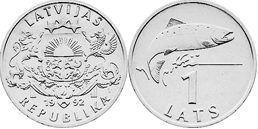
The Latvian lats was the currency of Latvia from 1922 until 1940 and from 1993 until it was replaced by the euro on 1 January 2014. A two-week transition period during which the lats was in circulation alongside the euro ended on 14 January 2014. The lats is abbreviated as Ls and was subdivided into 100 santīmi, abbreviated as an s after the santīm amount.

The tenge is the currency of Kazakhstan. It is divided into 100 tiyn.

The Singapore dollar is the official currency of the Republic of Singapore. It is divided into 100 cents. It is normally abbreviated with the dollar sign $, or S$ to distinguish it from other dollar-denominated currencies. The Monetary Authority of Singapore (MAS) issues the banknotes and coins of the Singapore dollar.

The Lithuanian litas (ISO currency code LTL, symbolized as Lt; plural litai or litų was the currency of Lithuania, until 1 January 2015, when it was replaced by the euro. It was divided into 100 centų. The litas was first introduced on 2 October 1922 after World War I, when Lithuania declared independence, and was reintroduced on 25 June 1993 following a period of currency exchange from the Soviet ruble to the litas with the temporary talonas then in place. The name was modeled after the name of the country. From 1994 to 2002, the litas was pegged to the U.S. dollar at the rate of 4 to 1. The litas was pegged to the euro at the rate of 3.4528 to 1 since 2002. The euro was expected to replace the litas by 1 January 2007, but persistent high inflation and the economic crisis delayed the switch.

The Armenian dram is the currency of Armenia. It was historically subdivided into 100 luma. The Central Bank of Armenia is responsible for issuance and circulation of dram banknotes and coins, as well as implementing the monetary policy of Armenia.

The hryvnia has been the national currency of Ukraine since 2 September 1996. The hryvnia is divided into 100 kopiyok. It is named after a measure of weight used in Kievan Rus'.
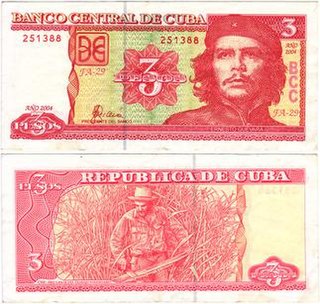
The Cuban peso also known as moneda nacional, is the official currency of Cuba.
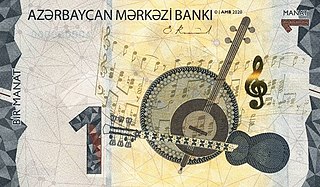
The manat is the currency of Azerbaijan. It is subdivided into 100 gapiks.

The Transnistrian ruble is the currency of the internationally unrecognized state of Transnistria. It is divided into 100 kopecks.
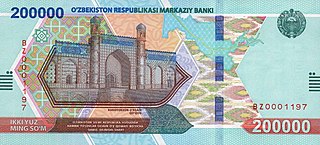
The sum is the official currency of Uzbekistan. Uzbekistan replaced the ruble with the sum at par in on 16 July 1994. No subdivisions of this sum were issued and only banknotes were produced, in denominations of 1, 3, 5, 10, 25, 50, 100, 200, 500, 1,000, 5,000, and 10,000 sum. Because it was meant to be a transitional currency, the design was rather simplistic.
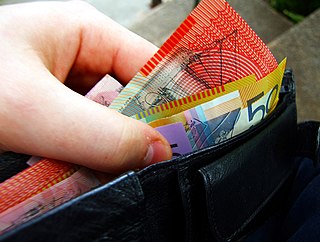
Polymer banknotes are banknotes made from a synthetic polymer such as biaxially oriented polypropylene (BOPP). Such notes incorporate many security features not available in paper banknotes, including the use of metameric inks. Polymer banknotes last significantly longer than paper notes, causing a decrease in environmental impact and a reduced cost of production and replacement. Modern polymer banknotes were first developed by the Reserve Bank of Australia (RBA), Commonwealth Scientific and Industrial Research Organisation (CSIRO) and The University of Melbourne. They were first issued as currency in Australia during 1988 ; by 1996, the Australian dollar was switched completely to polymer banknotes. Romania was the first country in Europe to issue a plastic note in 1999 and became the third country after Australia and New Zealand to fully convert to polymer by 2003.
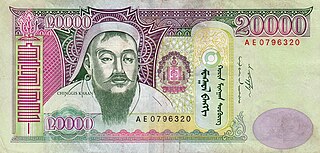
The tögrög or tugrik is the official currency of Mongolia. It was historically subdivided into 100 möngö. Currently, the lowest denomination in regular use is the 10-tögrög note, and the highest is the 20,000-tögrög note. In Unicode, the currency sign is U+20AE₮TUGRIK SIGN.

The ruble, rouble or rubel is the currency of Belarus. It is subdivided into 100 kopecks.
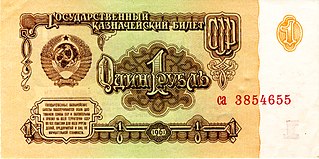
The ruble or rouble was the currency of the Soviet Union. It was introduced in 1922 and replaced the Imperial Russian ruble. One ruble was divided into 100 kopecks. Soviet banknotes and coins were produced by the Federal State Unitary Enterprise in Moscow and Leningrad.

The ruble was the currency of Tajikistan between 10 May 1995 and 29 October 2000. It was ostensibly subdivided into 100 tanga, although no coins or banknotes were issued denominated in tanga. The currency was only issued as paper money, with denominations to up to 10,000 rubles.

The Central Bank of Armenia is the central bank of Armenia with its headquarters in Yerevan. The CBA is an independent institution responsible for issuing all banknotes and coins in the country, overseeing and regulating the banking sector and keeping the government's currency reserves. The CBA is also the sole owner of the Armenian Mint.

The Brazilian real is the official currency of Brazil. It is subdivided into 100 centavos. The Central Bank of Brazil is the central bank and the issuing authority. The real replaced the cruzeiro real in 1994.